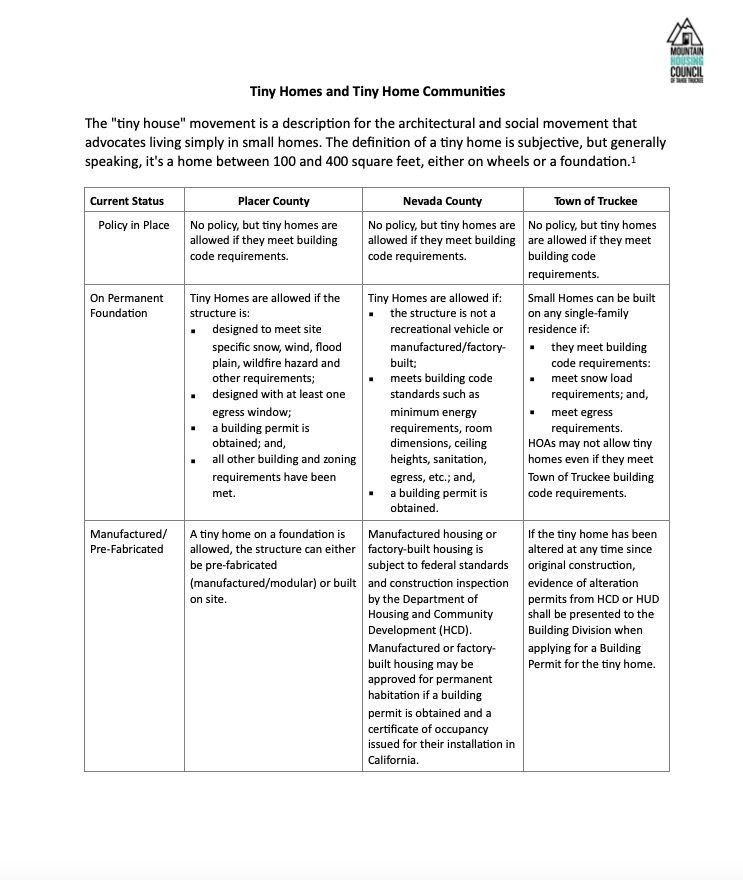Tiny House Sheet Includes The Town Of Truckee
Update: Sweeping update to Placer County housing policy targets infill areas for more housing July 14th, 2022
Increasing the variety and affordability of housing in Placer County’s developed unincorporated areas is the goal of a series of policy changes approved Tuesday by the county Board of Supervisors.
The proposed updates would align county code with sweeping changes to state law in recent years intended to address the growing housing affordability crisis in California. They would also allow innovative housing types like moveable tiny homes and co-housing or “cottage home” developments.
Placer and Nevada County have created a Tiny House Sheet by the Mountain Housing Council. The town of Truckee is also included. The Tiny House Sheet Addresses tiny houses on a foundation and ADUs. Tiny homes on wheels are allowed in RV and Mobile Home Parks.
Other code amendments allow for moveable tiny homes as primary or accessory dwelling units and “cluster” lot developments such as cottage home communities or co-housing.
Moveable tiny homes will be allowed on appropriately zoned parcels in unincorporated areas countywide, including the Lake Tahoe Basin, but will have the same water, sewer and electrical connections requirements as other permanent structures. Their trailer chassis and wheels also need to be concealed behind skirting.
The changes take effect July 14.

Placer County Accessory Dwelling Units
The state of California recognizes accessory dwelling units (ADUs) as an innovative and affordable way to create a more substantial housing supply for California. Now it is easier than ever for people to build an ADU! Legislators approved six laws to reduce barriers to building ADUs. These include allowing ADUs and JADUs to be built concurrently with a single-family dwelling, expanding the allowable zoning districts for ADUs to include all areas that allow single-family and multifamily uses, modifying fees from utilities and reductions in parking requirements.
As of January 01, 2020, all local ordinances regarding Secondary Dwelling Units are no longer applicable until the ordinances are complicit with current State law. Furthermore, homeowner associations (HOAs and CC&Rs) are also limited in their ability to restrict the construction of ADUs. Any governing document is void and unenforceable to the extent that it prohibits, or effectively prohibits, the construction or use of ADUs or junior ADUs
NEW! Fee reductions for ADUs
No impact fees will be assessed for units less than 750 square feet. For a unit that is 750 square feet or more, the impact fees are proportional to the primary unit.
- 749 Square Feet And Below – 0% –Percent Of Development Impact Fees Assessed
- 750-1000 Square Feet- 50%
- 1001 And Above Square Feet- 100%
The type of permits required to build an ADU can vary. See here for more Building Permit information or to begin your online application process.
What is an ADU?
An ADU is a secondary dwelling (also referred to as granny flats, in-law units, backyard cottages, etc.) that is complete with independent living facilities for one or more persons. There are generally three types:
Attached: The unit is attached to the primary structure
Detached: The unit is separate from the primary structure
Repurposed Existing Space: Space (e.g. master bedroom or garage) within the primary residence that is converted into an individual living space.
What is JADU?
Junior Accessory Dwelling Units (JADUs) are a specific type of ADU that is built within an existing residence and shall contain no more than 500 square feet. They may share central systems, contain a basic kitchen utilizing small plug-in appliances, may share a bathroom with the primary dwelling, all to reduce development costs.
What are the benefits?
ADUs are a cost-effective type of home that provides independent living space for family members and others. ADUs require no additional land costs, and they do not require any major new infrastructure. Recent state legislation has significantly reduced or eliminated fees for many ADU’s. This flexible living space can allow seniors to live independently while being close to family, provide an affordable living space for students and young professionals, and help provide supplemental income for the property owner.
Where are ADUs allowed?
ADUs are allowed in any zone that allows residential use. A maximum of one ADU and one JADU may be permitted on parcels with a single-family dwelling. On parcels with a multifamily development, the number of ADUs permitted within the footprint of the existing structure may be up to 25 percent of the number of existing units, or one unit, whichever is greater. Up to two detached ADUs may be permitted on a lot with an existing, legal multifamily development.
Size
An ADU is intended to be secondary in size to the primary home. An ADU that is attached to a primary dwelling may be up to 50% of the existing unit. An ADU that is detached from the primary home may be up to 1,200 square feet, regardless of the size of the primary structure.
There is no minimum lot size for an ADU, but adequate water and sewer or septic must be demonstrated.
Accessory Dwelling Unit Zoning Text Amendments
In response to recent changes in state law, the County Planning Division of the Community Development Resource Agency has prepared a new ordinance, which is expected to be heard by the County Planning Commission and Board of Supervisors in Spring 2020.
The purpose of the proposed secondary dwelling Zoning Text Amendment is to bring applicable regulations into compliance with recent changes to State law. In preparing its own ordinance the County, per State law, may modify certain State standards but must adhere to others. Based on the new State laws, the County’s current secondary dwelling regulations in the Zoning Ordinance must be amended. Some of the proposed changes do not apply to the Tahoe Basin because the regulations of secondary dwellings is in part governed by the Tahoe Basin Area Plan and the Tahoe Regional Planning Agency.
Placer County, California ADUs
Placer County Code
Current through Ordinance 6033-B and the October 2020 code supplement. For more recent amendments to this code, refer to the CodeAlert page.
Placer County Housing Related Code Amendments
Project Description
The County’s purpose in proposing the General Plan, Zoning Ordinance, and Community Design Guidelines Manual update is to provide a better framework for future housing development in the County that takes into account population growth, economic factors, demographics, and community needs and wants. This proposed project represents a component of a larger effort to implement elements of the Placer County Housing Strategy and Development Plan. The primary objectives of the Housing Related Code Amendments:
- Increase the availability of a mix of housing types in the County for existing and future residents, students, and employees whose income cannot support the cost of housing in the County;
- Improve the County’s overall employment growth by assisting County employers in reducing critical shortages of skilled workers in part driven by a lack of available housing;
- Reduce Vehicle Miles Travelled (VMT) per capita by shortening commute distances for those who commute within Placer County for education or work, or other metrics for VMT as determined appropriate by the County under SB 743 legislation, and
- Bring County housing policies, ordinances, standards, and guidelines into conformance with recent changes in State law.
Project Objectives
This proposed project is intended to implement the following objectives in addition to those of the Placer County Housing Strategy and Development Plan:
- Implement adopted General Plan policies that support efficient, resilient, and sustainable housing development patterns that can be achieved through higher density, mixed-use, transit-oriented, and infill development projects; and
- Align Placer County General Plan and Zoning Ordinance housing-related land uses development standards, and implementation methods with recently adopted specific plans, community plans, and area plans.
- Implement County adopted Strategic Plan (November 20, 2018) which supports new housing construction that provides a mix of housing types for people of all income ranges through for existing and future residents.
An Environmental Impact Report (EIR) will be prepared for this project. The EIR’s Notice of Preparation (NOP) comment period is August 29, 2019, through September 27, 2019. A public scoping meeting regarding the NOP is scheduled for Wednesday, September 18, 2019.
Housing Related Code Amendments

Photo Courtesy: Digz2Go NYU Designs
Tiny House Alliance USA Editor
The Future Of Tiny Is Now!
Janet Thome Founder And President
janet@tinyhouseallianceusa.org
509 345 2013
Founder Of Tiny Portable Cedar Cabins


Pingback: California Regulation Of Tiny Houses - Tiny House Alliance USA